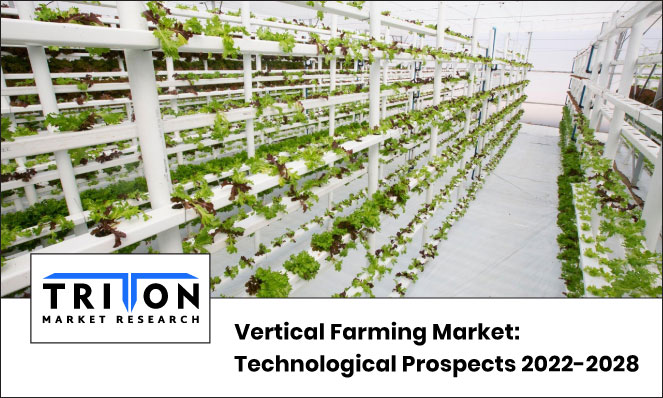



24, November 2022

Vertical farming – a closed environment crop-growing technique has gained prominence globally owing to high food consumption and lack of arable land for cultivation. The volume of global food consumption reached 2.5 billion metric tons in 2021. This elevates the need for this technique to reduce reliance on weather, high soil fertility, and water consumption. Our estimates indicate that the global vertical farming market is set to propel at a CAGR of 23.10% from 2022 to 2028.
Several crops have been grown in stacked layers in skyscrapers, warehouses, or shipping containers in recent years, especially in Asia and Europe. For instance, Vertical Future, a London-based company, concluded research to deliver sustainable fresh produce with zero agrichemical components. Hence, a gradual shift from conventional agrochemical-based farming to sustainable controlled environment agriculture has widened the market’s scope.
Lighting category captures the major share in terms of offering and is expected to continue its dominance over the forecast period. Farming with lighting technology enables consistent plant growth, reducing the heat stress on roots and ensuring uniform lighting. LED, in this regard, is a popular supplementary light source as it consumes 85% less heat than high-pressure sodium (HPS) lights.
Hence, the LED grow light is set to become the most sought-after technology, forecasted to reach about $12 billion by 2030. GoodLeaf, a Canadian vertical farm, is among the many to have replaced old lighting systems with LED to grow varied crops and reduce overall energy-related costs in vertical farming. Overall, the growing implementation of this technique in skyscrapers and greenhouses is estimated to drive the market’s demand in the coming years.
Vertical farming is inclined towards deploying sensors to store information in the cloud and analyze data in real time using the internet of things (IoT). Increasing government support for modern agricultural techniques has boosted the demand for these sensors in the market. For example, the European Commission introduced the Farm Advisory System to help farmers understand rules for animal health, agriculture, and the environment.
Another development includes collaboration between International Rice Research Institute and government partners to introduce the Cereal System initiative in South Asia to offer tools for location-specific fertilizer recommendations to growers. Estimates indicate C02 sensors to be a popular device, followed by pH, EC, and magnetometer sensors.
Climate control is a critical aspect of indoor farming techniques, with air quality control gaining major prominence. Hence, CO2 enrichment methods have been adopted to saturate CO2 solutions, reducing overall cost and the need for additional equipment such as HVAC systems. Since the build-up of heat and humidity in the growing area increases the risk of infection, vertical planes are incorporated as it allows air to move easily compared to horizontal layouts.
However, the rising need for airflow examination has influenced players to introduce new systems, such as the airflow monitoring system by Kanomax that measures air velocity 24/7, enabling farmers to intervene in real time if the airflow is poor or excessive. The deployment of such advanced systems creates opportunities for operating players to launch new products, thus driving the market.
In addition to being economically viable in the food industry, vertical farming is expected to show significant prominence in the biopharma sector in the upcoming years. Molecular farming, in this scenario, holds the potential to offer proteins that can be used as a therapeutic tool in healthcare and life sciences. In line with this, a few bio-pharma companies like Abattis Bioceuticals Corp have adopted vertical farming technology to produce nutraceutical components. Therefore, the adoption of advanced solutions like indoor cultivation will accelerate the vertical farming market’s development over the forecast period.
Several countries in the Asia-Pacific and Europe have adopted vertical farming techniques, including Japan, China, Singapore, the UK, France, and the Netherlands.
Q2) Which are the key crop types in the vertical farming market?Tomato, berries, pepper, cucumber, microgreens, lettuce and leafy vegetables, and others are key crop types in the vertical farming market.

Prevalent cases of terrorist attacks in today’s world is increasing the need for severe standards of security for public safety, and the global market for biometric technology scrupulously accommoda..
Prevalent cases of terrorist attacks in today’s world is increasing the need for..